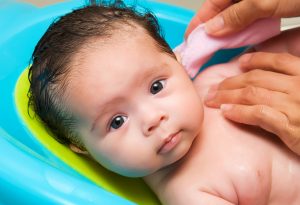In this Article
A baby can get sick due to numerous environmental reasons or internal body function problems. One key aspect of measuring health is monitoring the baby’s internal body temperature. Much like an adult’s body, if the temperature goes out of control your baby could have a heat stroke. In these circumstances, if you aren’t careful, your baby could suffer grave consequences. One of the first steps to combating this condition is understanding it.
What is Heat Stroke?
A human body has a regulated internal temperature, this keeps the blood flowing, organs healthy and helps keep you fit. Your baby’s body is still growing but it still has an automated system to keep the temperature in check and a system for cooling down. When this system is compromised, your baby is at risk of an unregulated rise in body temperature. This can be extremely dangerous and potentially fatal. When your baby’s body begins to overheat beyond their control and doesn’t cool down it is known as a heat stroke.
Causes of Heat Stroke in Infants
A key aspect of fighting a heat stroke is to understand the causes of a heat stroke, a few of these include
- Dehydration
- Extremely high external temperature
- Malnutrition
- Stuffy or suffocating clothing
- Lack of oxygen in hot environments.
To learn more about the causes of your baby’s heat stroke visit your closest doctor.
Signs and Symptoms of Heat Stroke
Beyond understanding the causes of a heat stroke, it is also extremely important to understand how to identify if your baby is having a heat stroke. Here are some of the symptoms of baby overheating:
- A fever that is above 103 degrees Fahrenheit in which your baby does not sweat is one of the signs of a heat stroke. In Celsius, this temperature would be above 39 degrees.
- If your baby is extremely tired or fatigued for long periods of time in the summer months or after spending time in a hot room, they could be having a heat stroke.
- If you suspect your child of having a heat stroke, ensure you check their pulse for one minute, if it is rapid then it could be a sign of a heat stroke.
- If your child has skin that is burning hot and is red and dry, they could be symptoms of a heat stroke.
- Dizziness or disorientation is a sign of a heat stroke, especially in hotter temperatures
It is important to understand that other symptoms could manifest in the forms of headaches, restlessness, vomiting or even your child losing consciousness. If these symptoms are relevant to your baby, please see a doctor immediately.
Treatment for Heat Exhaustion
It is highly recommended that you call an ambulance and have your baby checked at the nearest hospital in case of a serious heat stroke. Here are a few things you can do for minor heat strokes:
- Dress your baby in loose clothing
- Have them lay under a fan or indoors in a room with air conditioning
- Pat down their forehead and shoulders with a cold wet cloth
- Put them in an ice bath

For further information regarding treating minor heat strokes, contact your primary care physician.
Prevention of Heat Stroke in Babies
It can be extremely difficult to predict heat exhaustion in babies. Here are a few ways to avoid them:
- Dress your baby in loose clothing
- Keep them indoors if it is especially hot outside
- Keep them hydrated
- Ensure you expose your child to warmer or hotter weather gradually
- Limit the time they spend outdoors during the peak of the afternoons
- Sit with them in a room with fans and air conditioning
- Avoid spicy foods during the hotter periods of the year
Heat strokes can be extremely dangerous if precautions aren’t taken. Talk to your doctor about the steps you need to take to avoid a heat stroke for your baby. Remember, prevention is the best cure.









